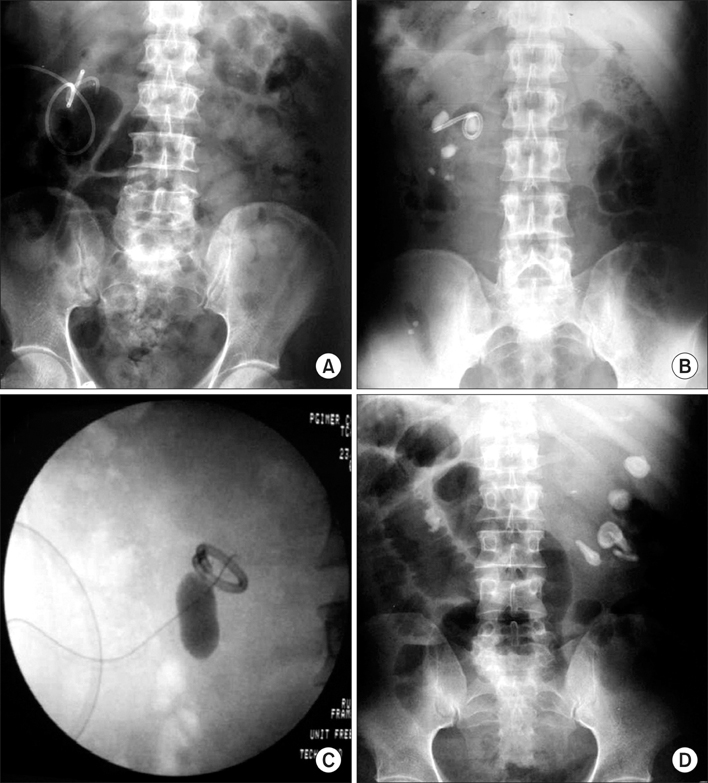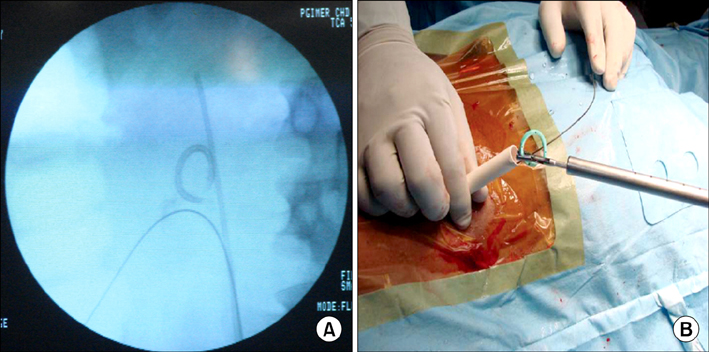Korean J Urol.
2012 Jul;53(7):492-496. 10.4111/kju.2012.53.7.492.
Fragmented Pigtail Percutaneous Nephrostomy Tubes: Etiology and Management
- Affiliations
-
- 1Department of Urology, Postgraduate Institute of Medical Education and Research, Chandigarh, India. santoshsp1967jaimatadi@yahoo.co.in
- KMID: 1988762
- DOI: http://doi.org/10.4111/kju.2012.53.7.492
Abstract
- PURPOSE
To review our experience with the management of fragmented and retained pigtail percutaneous nephrostomy (PCN) tubes and to explore the reasons for the fragmentation.
MATERIALS AND METHODS
We retrospectively reviewed our institute database from January 2006 to December 2011 for patients who had undergone retrieval of fragmented PCN tubes. We assessed the preoperative factors, operative technique, and post-operative outcomes.
RESULTS
A total of seven patients (4 males and 3 females) had been diagnosed with fragmented PCN tubes. The mean age of the patients was 41.5 years. Of the seven patients, five required antegrade instrumentation by way of a percutaneous tract to remove the foreign body, mostly along with stone retrieval. One patient underwent ureterorenoscopy and pneumolithotripsy for a ureteric stone along with ureteroscopic removal of the PCN fragment. Another patient underwent nephrectomy of the kidney containing the PCN fragment because it had become nonfunctioning. All patients were free of stones and symptoms on follow-up.
CONCLUSIONS
A prolonged waiting period for definitive surgery, urinary infection, and associated stone disease are significant factors causing fragmentation of PCN tubes. Proper insertion techniques, regular timed changes of the PCN tube, appropriate care of the PCN tube, and early surgery for underlying stone disease are required to avoid this complication. Patients with retained PCN tubes can be managed effectively with antegrade or retrograde endoscopic techniques while definitive management of the primary pathology is carried out, without any additional morbidity.
MeSH Terms
Figure
Reference
-
1. Goodwin WE, Casey WC, Woolf W. Percutaneous trocar (needle) nephrostomy in hydronephrosis. J Am Med Assoc. 1955. 157:891–894.2. Lee WJ, Badlani GH, Smith AD. Percutaneous nephrostomy for endopyelotomy. AJR Am J Roentgenol. 1987. 148:189–192.3. Zagoria RJ, Dyer RB. Do's and don't's of percutaneous nephrostomy. Acad Radiol. 1999. 6:370–377.4. Lee WJ. Han MC, Park JH, editors. Percutenaous nephrostomy. Interventional radiology. 1999. Seoul: Ilchokak;591–600.5. Banner MP, Ramchandani P, Pollack HM. Interventional procedures in the upper urinary tract. Cardiovasc Intervent Radiol. 1991. 14:267–284.6. el-Faqih SR, Shamsuddin AB, Chakrabarti A, Atassi R, Kardar AH, Osman MK, et al. Polyurethane internal ureteral stents in treatment of stone patients: morbidity related to indwelling times. J Urol. 1991. 146:1487–1491.7. Marx M, Bettmann MA, Bridge S, Brodsky G, Boxt LM, Richie JP. The effects of various indwelling ureteral catheter materials on the normal canine ureter. J Urol. 1988. 139:180–185.8. Beiko DT, Knudsen BE, Watterson JD, Cadieux PA, Reid G, Denstedt JD. Urinary tract biomaterials. J Urol. 2004. 171(6 Pt 1):2438–2444.9. Hwang TK. Percutaneous nephroscopic surgery. Korean J Urol. 2010. 51:298–307.10. Mardis HK, Kroeger RM, Hepperlen TW, Mazer MJ, Kammandel H. Polyethylene double-pigtail ureteral stents. Urol Clin North Am. 1982. 9:95–101.11. Zisman A, Siegel YI, Siegmann A, Lindner A. Spontaneous ureteral stent fragmentation. J Urol. 1995. 153(3 Pt 1):718–721.12. Schulze KA, Wettlaufer JN, Oldani G. Encrustation and stone formation: complication of indwelling ureteral stents. Urology. 1985. 25:616–619.



